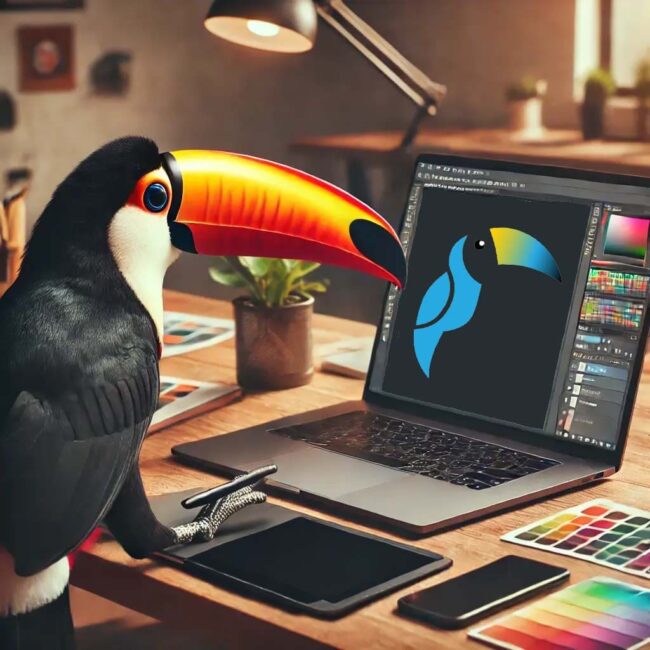In the world of branding, a logo is more than just a visual mark; it’s the face of a company, a symbol of its identity, and a key element in its marketing strategy. Over the years, certain logos have stood out, becoming iconic symbols recognized worldwide. Here, we explore the top 20 logos of all time, celebrated for their design, impact, and timeless appeal.
We’ve designed many logos and would be delighted to work on yours! Whether to create a brand new one or modernise an existing logo. You can trust Tukan Digital Agency to use its creativity at your service.
- Apple
The bitten apple logo is synonymous with innovation and sleek design. Created by Rob Janoff in 1977, this logo has evolved from its original rainbow-striped version to the minimalist monochrome icon we know today. The simplicity and elegance of the design reflect Apple’s philosophy of creating user-friendly and aesthetically pleasing products. The bite in the apple was included to ensure it was not mistaken for a cherry, adding a touch of whimsy to the design.
Apple’s logo has become a symbol of the brand’s commitment to innovation and quality. Over the years, it has been associated with groundbreaking products like the Macintosh, iPod, iPhone, and iPad. The logo’s evolution mirrors the company’s journey from a niche computer manufacturer to a global technology leader. Its sleek, modern design aligns perfectly with Apple’s brand identity, making it one of the most recognizable logos in the world.
- Nike
The Nike Swoosh, designed by Carolyn Davidson in 1971, represents motion and speed. It’s a perfect example of a simple yet powerful logo that has become a global symbol of athletic excellence. The Swoosh is inspired by the wing of the Greek goddess Nike, symbolizing victory and triumph. This connection to Greek mythology adds a layer of depth and meaning to the logo, enhancing its appeal.
Nike’s logo has played a crucial role in establishing the brand’s identity. It embodies the spirit of athleticism and the pursuit of excellence, resonating with athletes and sports enthusiasts worldwide. The Swoosh’s simplicity allows it to be easily recognizable and versatile, making it effective across various mediums and products. Over the years, it has become synonymous with high-performance sportswear and footwear, cementing Nike’s position as a leader in the industry.
- Coca-Cola
Coca-Cola’s logo, with its distinctive Spencerian script, has remained largely unchanged since its creation in 1886. It’s a timeless design that evokes nostalgia and brand loyalty. The flowing script and red color convey a sense of tradition and happiness, making it one of the most recognizable logos in the world. The logo’s consistency over the years has helped maintain a strong brand identity, reinforcing Coca-Cola’s position as a market leader.
The Coca-Cola logo is more than just a visual mark; it’s a symbol of the brand’s heritage and global presence. The script was designed by Frank Mason Robinson, who believed that the two Cs would look well in advertising. The logo’s enduring appeal lies in its ability to evoke positive emotions and memories, making it a powerful tool for brand recognition and loyalty. Its association with happiness and refreshment has made it an integral part of popular culture.
- McDonald’s
The Golden Arches of McDonald’s are one of the most recognizable symbols in the world. Introduced in 1961, the logo represents the brand’s global presence and fast-food dominance. The arches were inspired by the architecture of early McDonald’s restaurants and have come to symbolize convenience and consistency. The bright yellow color is associated with happiness and energy, making the logo appealing to a wide audience.
McDonald’s logo has played a significant role in the brand’s success. It represents the company’s commitment to providing quick and affordable meals to customers worldwide. The Golden Arches have become a symbol of the fast-food industry, representing the brand’s promise of quality and service. Over the years, the logo has been adapted for various marketing campaigns, but its core design has remained consistent, reinforcing McDonald’s brand identity.
- Google
Google’s logo has undergone several changes since its inception in 1998, but its colorful simplicity remains a constant. The current design, introduced in 2015, reflects the company’s playful and innovative spirit. The use of primary colors, with a touch of green, signifies Google’s unconventional approach to business. The logo’s clean and modern design aligns with the company’s mission to organize the world’s information and make it universally accessible.
Google’s logo is a reflection of the brand’s dynamic and evolving nature. The playful design elements convey a sense of creativity and innovation, which are core values of the company. The logo’s evolution has mirrored Google’s growth from a search engine to a global technology leader. Its simplicity and versatility make it effective across various platforms, from web browsers to mobile devices, ensuring consistent brand recognition.
- Mercedes-Benz
The three-pointed star of Mercedes-Benz, symbolizing land, sea, and air, was first used in 1909. It’s a mark of luxury and engineering excellence. The logo represents the brand’s ambition to dominate transportation across all terrains, and its sleek design conveys sophistication and quality. The silver color adds a touch of elegance, reinforcing the brand’s premium image.
Mercedes-Benz’s logo is a testament to the brand’s commitment to innovation and excellence. The three-pointed star has become a symbol of luxury and performance, representing the brand’s heritage and future aspirations. Over the years, the logo has been associated with high-quality engineering and cutting-edge technology, making it a powerful symbol of the brand’s identity. Its timeless design ensures that it remains relevant and recognizable in the ever-evolving automotive industry.
- FedEx
The FedEx logo, designed by Lindon Leader in 1994, is famous for its hidden arrow, symbolizing speed and precision. It’s a masterclass in clever design and subtlety. The arrow, formed between the letters E and X, represents the company’s commitment to fast and reliable delivery services. The use of bold colors and clean typography enhances the logo’s visibility and impact.
FedEx’s logo is a perfect example of how design can communicate a brand’s values and mission. The hidden arrow is a subtle yet powerful element that reinforces the brand’s promise of speed and efficiency. The logo’s simplicity and clarity make it easily recognizable, ensuring strong brand recognition. Over the years, it has become a symbol of reliability and trust, helping FedEx establish itself as a leader in the logistics industry.
- Amazon
Amazon’s logo, with its smiley arrow pointing from A to Z, signifies the company’s wide range of products and customer satisfaction. It’s a friendly and approachable design that resonates with consumers. The arrow also suggests movement and progress, reflecting Amazon’s continuous growth and innovation. The use of a simple, sans-serif font adds to the logo’s modern and clean look.
Amazon’s logo is a reflection of the brand’s customer-centric approach. The smiley arrow conveys a sense of happiness and satisfaction, reinforcing the company’s commitment to providing a positive shopping experience. The logo’s design elements highlight Amazon’s extensive product range and global reach, making it a powerful symbol of the brand’s identity. Its versatility and simplicity ensure that it remains effective across various platforms and marketing materials.
- Pepsi
Pepsi’s logo has seen many iterations since its creation in 1898. The current design, introduced in 2008, features a globe-like symbol that represents the brand’s global reach and youthful energy. The red, white, and blue colors are a nod to the American flag, emphasizing the brand’s heritage. The logo’s dynamic and modern design reflects Pepsi’s focus on innovation and staying relevant in a competitive market.
Pepsi’s logo is a testament to the brand’s ability to evolve and adapt to changing trends. The globe-like symbol conveys a sense of movement and energy, aligning with the brand’s youthful and vibrant image. The use of bold colors and clean lines ensures that the logo is easily recognizable and impactful. Over the years, the logo has become a symbol of refreshment and fun, helping Pepsi maintain its position as a leading beverage brand.
- IBM
The IBM logo, designed by Paul Rand in 1972, features bold, horizontal stripes that convey stability and innovation. It’s a classic example of corporate branding. The stripes suggest speed and dynamism, while the solid, blocky letters communicate strength and reliability. The blue color adds a touch of professionalism, reinforcing the brand’s corporate image.
IBM’s logo is a reflection of the brand’s commitment to innovation and excellence. The bold design elements convey a sense of strength and stability, aligning with the company’s reputation as a leader in technology and business solutions. The logo’s simplicity and clarity ensure that it remains effective across various platforms and marketing materials. Over the years, it has become a symbol of trust and reliability, helping IBM maintain its position as a global technology leader.
- Shell
The Shell logo, with its distinctive scallop shell design, has been in use since 1904. It’s a symbol of the company’s heritage and commitment to quality. The bright red and yellow colors are inspired by the Spanish flag, reflecting the company’s early connections with Spain. The logo’s bold and simple design ensures strong brand recognition and visibility.
Shell’s logo is a testament to the brand’s ability to maintain a strong identity over the years. The scallop shell design is a nod to the company’s origins and heritage, while the bright colors convey a sense of energy and vitality. The logo’s simplicity and clarity make it easily recognizable, ensuring strong brand recognition. Over the years, it has become a symbol of quality and reliability, helping Shell establish itself as a leading energy company.
- Starbucks
Starbucks’ logo, featuring a twin-tailed mermaid, has evolved over the years but remains a symbol of the brand’s coffee culture and global presence. The mermaid, or siren, represents the allure and mystery of the sea, tying back to the company’s maritime roots. The green color conveys a sense of growth and freshness, aligning with the brand’s commitment to sustainability and quality.
The Starbucks logo has undergone several redesigns, with the most significant change occurring in 2011 when the company removed the wordmark, leaving just the siren. This bold move emphasized the strength of the visual symbol alone. The logo’s evolution reflects Starbucks’ growth from a single coffee shop in Seattle to a global coffeehouse chain. Its distinctive design and strong brand identity have made it an iconic symbol in the coffee industry.
- Adidas
The three stripes of Adidas, introduced in 1949, represent the brand’s focus on performance and style. It’s a simple yet powerful design that has become iconic in the sports world. The stripes are meant to convey a sense of movement and athleticism, aligning with the brand’s mission to support athletes in their pursuit of excellence.
Adidas’ logo has become synonymous with high-quality sportswear and footwear. The three stripes are not just a design element but a symbol of the brand’s heritage and commitment to innovation. Over the years, the logo has been adapted for various product lines, including the Trefoil logo for lifestyle products and the Performance logo for athletic gear. This versatility has helped Adidas maintain a strong brand presence across different markets.
- Microsoft
Microsoft’s logo, with its four colorful squares, represents the company’s diverse range of products and services. The current design, introduced in 2012, reflects a modern and dynamic brand. The squares symbolize the company’s core areas: Windows, Office, Xbox, and Surface. The use of bright colors conveys a sense of creativity and innovation.
Microsoft’s logo is a reflection of the brand’s evolution and growth. The clean and simple design aligns with the company’s mission to empower individuals and organizations through technology. The logo’s versatility allows it to be effective across various platforms, from software interfaces to hardware products. Its modern design and vibrant colors ensure that it remains relevant in the fast-paced tech industry.
- Twitter
The Twitter bird, named Larry, has become a symbol of social media and digital communication. The logo, introduced in 2010, is simple, friendly, and instantly recognizable. The bird represents freedom and the ability to connect with others, mirroring the platform’s purpose. The blue color conveys a sense of trust and reliability.
Twitter’s logo has played a crucial role in establishing the platform’s identity. The simplicity of the design makes it easily recognizable and versatile, ensuring strong brand recognition. The bird’s upward flight symbolizes growth and progress, aligning with Twitter’s mission to provide a platform for real-time information and conversation. Over the years, the logo has become a symbol of social media and digital communication. Although today it has been replaced by X.
- BMW
The BMW logo, with its blue and white quarters, represents the company’s Bavarian heritage and engineering excellence. It’s a timeless design that has remained largely unchanged since 1917. The blue and white colors are derived from the Bavarian flag, and the circular shape suggests movement and innovation.
BMW’s logo is a testament to the brand’s commitment to quality and performance. The design elements convey a sense of precision and engineering excellence, aligning with the company’s reputation as a leader in the automotive industry. The logo’s simplicity and clarity ensure that it remains effective across various platforms, from car badges to marketing materials. Its timeless design has helped BMW maintain a strong brand identity over the years.
- Chanel
The interlocking Cs of Chanel, designed by Coco Chanel herself, are a symbol of luxury and elegance. The logo, introduced in 1925, is a timeless representation of the brand’s fashion legacy. The simplicity and symmetry of the design reflect the brand’s commitment to sophistication and style.
Chanel’s logo has become synonymous with high fashion and luxury. The interlocking Cs are a powerful symbol of the brand’s heritage and commitment to quality. Over the years, the logo has been associated with some of the most iconic fashion pieces, from the little black dress to the Chanel No. 5 perfume. Its timeless design ensures that it remains relevant and recognizable in the ever-evolving fashion industry.
- Volkswagen
The VW logo, with its simple and clean design, represents the brand’s commitment to quality and innovation. It’s a classic example of effective automotive branding. The interlocking V and W letters are enclosed in a circle, symbolizing unity and perfection. The logo’s simplicity and clarity make it easily recognizable and impactful.
Volkswagen’s logo is a reflection of the brand’s values and mission. The clean and modern design aligns with the company’s commitment to producing high-quality and innovative vehicles. The logo’s versatility allows it to be effective across various platforms, from car badges to marketing materials. Its timeless design has helped Volkswagen maintain a strong brand identity over the years.
- Instagram
Instagram’s logo, featuring a simplified camera icon, reflects the app’s focus on visual storytelling and creativity. The current design, introduced in 2016, is modern and vibrant. The gradient colors convey a sense of fun and excitement, aligning with the platform’s youthful user base.
Instagram’s logo is a reflection of the brand’s evolution and growth. The simplified camera icon is a nod to the app’s original purpose of photo sharing, while the vibrant colors convey a sense of creativity and innovation. The logo’s modern design ensures that it remains relevant in the fast-paced world of social media. Its versatility and simplicity make it effective across various platforms, from mobile apps to marketing materials.
- Disney
The Disney logo, with its iconic castle and whimsical font, represents the magic and wonder of the brand. It’s a symbol of storytelling and imagination that resonates with audiences of all ages. The castle is inspired by Disneyland’s Sleeping Beauty Castle, and the font evokes a sense of fantasy and adventure.
Disney’s logo is a testament to the brand’s ability to create magical experiences. The iconic castle and whimsical font convey a sense of wonder and excitement, aligning with the company’s mission to entertain and inspire. The logo’s timeless design ensures that it remains relevant and recognizable across various platforms, from movies to theme parks. Its association with storytelling and imagination has made it an integral part of popular culture.
We’ve designed many logos and would be delighted to work on yours! Whether to create a brand new one or modernise an existing logo. You can trust Tukan Digital Agency to use its creativity at your service.





